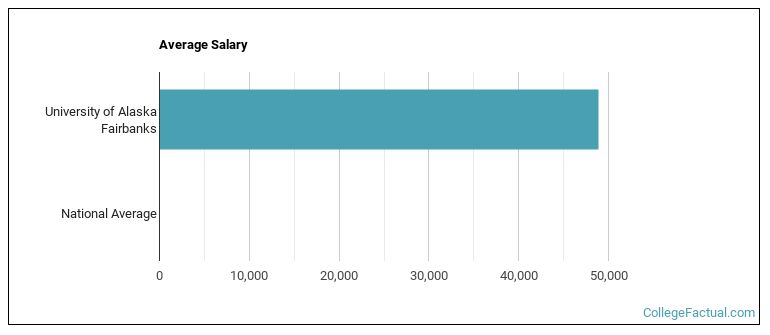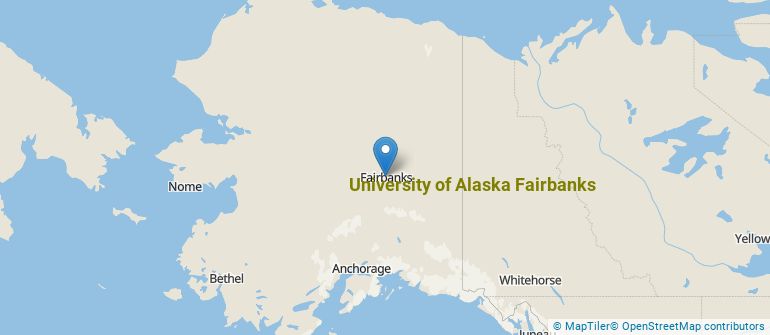 by our College Data Analytics Team
by our College Data Analytics TeamExplore the best ranked schools for the programs you are most interested in.
UAF landed the #1,632 spot in College Factual's 2025 ranking of best overall colleges in the United States. The higher ed experts analyzed 2,152 colleges and universities across the nation to determine this ranking.
UAF is also ranked #3 out of 4 schools in Alaska.
As long as you meet basic requirements, you should not have any trouble getting into University of Alaska Fairbanks since the school has an open admissions policy. Still, be sure to submit any requested materials and that your application is completed in full.
The student to faculty ratio is often used to measure the number of teaching resources that a college or university offers its students. The national average for this metric is 15 to 1, but at UAF it is much better at 11 to 1. That's good news for students who want to interact more on a personal level with their teachers.
In addition to the student to faculty ratio, some people look at what percentage of faculty members are full-time as a sign of how much time professors will be able to spend with their students. This is because part-time teachers may not be be on campus as much as their full-time counterparts.
The full-time faculty percentage at University of Alaska Fairbanks is 62%. This is higher than the national average of 47%.
The freshmen retention rate tells us what percentage of first-year, full-time students choose to continue on to their sophomore year at a particular school. The rate at University of Alaska Fairbanks is 70%, which is about average when compared to the national rate of 68%.
The on-time graduation rate is the percent of first-time, full time students who obtain their bachelor's degree in four years or less. This rate is 22% for first-time, full-time students at UAF, which is lower than the national rate of 33.3%.
Find out more about the retention and graduation rates at University of Alaska Fairbanks.
During the 2017-2018 academic year, there were 5,850 undergraduates at UAF with 2,399 being full-time and 3,451 being part-time.
| $0-30 K | $30K-48K | $48-75 | $75-110K | $110K + |
|---|---|---|---|---|
| $5,742 | $5,012 | $9,676 | $13,915 | $14,500 |
The net price is calculated by adding tuition, room, board and other costs and subtracting financial aid.Note that the net price is typically less than the published for a school. For more information on the sticker price of UAF, see our tuition and fees and room and board pages.
Almost 66% of college students who graduated with the class of 2018 took out student loans, but that percentage varies from school to school. At UAF, approximately 21% of students took out student loans averaging $5,705 a year. That adds up to $22,820 over four years for those students.
The student loan default rate at UAF is 1.0%. This is significantly lower than the national default rate of 10.1%, which is a good sign that you'll be able to pay back your student loans.
Get more details about paying for University of Alaska Fairbanks.

See which majors at University of Alaska Fairbanks make the most money.
Get more details about the location of University of Alaska Fairbanks.

Contact details for UAF are given below.
| Contact Details | |
|---|---|
| Address: | 1731 South Chandalar Drive, Fairbanks, AK 99775 |
| Phone: | 907-474-7034 |
| Website: | www.uaf.edu/ |
| Most Popular Majors | Bachelor’s Degrees | Average Salary of Graduates |
|---|---|---|
| Business Administration & Management | 134 | $46,949 |
| General Engineering | 127 | NA |
| Teacher Education Grade Specific | 69 | $51,619 |
| Liberal Arts General Studies | 64 | NA |
| General Biology | 49 | $31,392 |
| Vehicle Maintenance & Repair | 48 | NA |
| Accounting | 44 | $50,581 |
| Homeland Security | 44 | NA |
| Other Multi/Interdisciplinary Studies | 38 | $39,103 |
| Mechanical Engineering | 34 | $79,438 |
Online learning options are becoming more and more popular at American colleges and universities. Online classes are great for students who have busy schedules or for those who just want to study on their own time.
In 2022-2023, 5,088 students took at least one online class at University of Alaska Fairbanks. This is a decrease from the 5,402 students who took online classes the previous year.
| Year | Took at Least One Online Class | Took All Classes Online |
|---|---|---|
| 2022-2023 | 5,088 | 3,183 |
| 2021-2022 | 5,402 | 3,455 |
| 2020-2021 | 6,106 | 4,305 |
| 2018-2019 | 4,440 | 2,662 |
Learn more about online learning at University of Alaska Fairbanks.
If you’re considering University of Alaska Fairbanks, here are some more schools you may be interested in knowing more about.
Curious on how these schools stack up against UAF? Pit them head to head with College Combat, our free interactive tool that lets you compare college on the features that matter most to you!
Footnotes
*The racial-ethnic minorities count is calculated by taking the total number of students and subtracting white students, international students, and students whose race/ethnicity was unknown. This number is then divided by the total number of students at the school to obtain the racial-ethnic minorities percentage.
References
More about our data sources and methodologies.